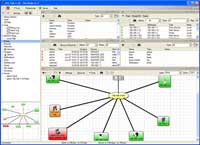Author: Joseph Moran
Review Date: 11/14/2007
![]()

Networks can be like closets: They start out completely organized, but then over time as items are added and stuff gets moved around, pretty soon you end up with a bit of a mess, with items that may or may not be working – or needed. This is why network management applications can be so useful — they help you inventory and track all the devices on your network while watching out for network problems that may occur.
This kind of software typically costs several hundred dollars or more, but Latvian networking hardware and software maker MikroTik’s The Dude is considerably less expensive than that. In fact, it’s free, and while the oddly named utility (“Dude, Where’s My Network?”) doesn’t have even close to the same level of polish as network monitoring tools you have to pay for, it can do a decent job, provided you’re willing to spend time figuring out its idiosyncratic interface and experimenting with its features.
The Dude runs on Windows (Vista, XP, or 2000), MacOS X, or Linux using a client/server design, which means the server component runs in the background on a PC while you interact with the server using a separate client utility. Since The Dude supports both local and remote connections, you can run the client on the same system as the server or any other system on the network. The Secure connections are also possible when connecting remotely.
Network Mapping. Monitoring, and Notification
When you fire up The Dude network monitor for the first time, it automatically detects any existing subnets and begins scanning them. Detected devices are then probed to determine which of more than a dozen IP-based services they support (like NetBIOS, HTTP, FTP and so on), but you can add your own probes for any services that aren’t already pre-configured.
After The Dude completes its discovery process, the results are plotted as icons on a map grid. Mousing over a device’s icon brings up a pop-up dialog which provides a lot of useful information at a glance, including which of its services are up, down, or unstable, as well as a graph that displays the device’s network activity for the past hour.
The Dude’s network maps are highly adjustable, and you easily can change their layouts and the orientation of devices. If you have a mouse with a wheel you can use it to zoom in or out of the map, and for crowded networks an adjacent birds-eye view lets you navigate large maps by quickly navigating to a particular section.
Right-clicking a device on the map brings up a tools menu that allows you to make contact with the device in a number of ways, ranging from ping to FTP or telnet connections. For devices that run RouterOS (MikroTik’s proprietary network operating system), you can also do things like check bandwidth to a device or monitor its traffic in real-time.
When a monitored device goes offline, its network map icon turns red. The Dude can issue notifications when this occurs, but it doesn’t do so by default (other than to post entries to an event log). Other supported notification methods include sending e-mails, playing sounds or presenting pop-up warnings (no pager or SMS support). The notification option must be individually enabled and configured on a per-device basis; it would have been nice to have an automatic default alert if any network device went incommunicado, but we couldn’t find a way to configure that.
Interface and Customization
The Dude network monitor offers the capability to customize countless configuration options, but unfortunately its user interface is not particularly attractive or intuitive, and some people will find it downright confusing at times. Like many applications, The Dude uses a two-pane interface that lets you select a configuration item from a list on the left and view it on the right.
While this seems logical enough, the arrangement doesn’t work very well in practice. For example, each time you select a configuration item it generates a new right-hand window that tiles vertically with those that are already open. This quickly leads to a very busy layout until you manually re-orient all of the windows so that they’re all properly visible.
Making the task a bit easier is the fact that each configuration window has a series of buttons that will split it vertically or horizontally, allowing you to open additional windows in the free space created. Also on the plus side is the fact that The Dude’s window layout is stored on the server rather than the client, so once you get everything set up the way you like it you can view it the same way from multiple clients.
The Dude offers ways to customize its behavior as well as appearance, including the capability to control how often network polling is preformed, how long to wait before timing out a device, and which services are polled on which devices. Interface issues rear their head here too, though. The configuration dialogs lack scroll bars, and as you select categories via an expandable hierarchy, the dialog box simply grows until it’s the full height of your display, leaving certain configuration options unavailable off-screen unless you reclaim space by closing others.
If you’d prefer to administer The Dude via a browser, you can use its Web-based interface, but it doesn’t duplicate all of the configuration options available in the Windows client. (The browser-based client does allow the use of SSL for secure remote connections.)
It’s not unusual for free software to offer limited documentation, and The Dude is no exception. Documentation consists only of a fairly short online wiki (which can also be downloaded as a PDF file) that provides a very basic top-level look at the software and doesn’t cover how to use many program features in any real depth. The Dude’s docs are also somewhat out of date since they haven’t been revised since version 1.0 of the software (we looked at v2.2 and beta releases of v3.0).
Although The Dude delivers many of the same capabilities that you’d find in pricey network monitoring tools, it could definitely use a better interface and more comprehensive and current documentation. Of course, it’s really hard to argue with the price, and as long as ease-of-use isn’t your main priority and you don’t mind tinkering, The Dude is a decent network utility that should be worth the download.
Pros: Free, lots of customizable options, useful network mapping features
Cons: Rather unintuitive user interface, device alerts not turned on by default, minimal and out of date documentation
Adapted from winplanet.com.



